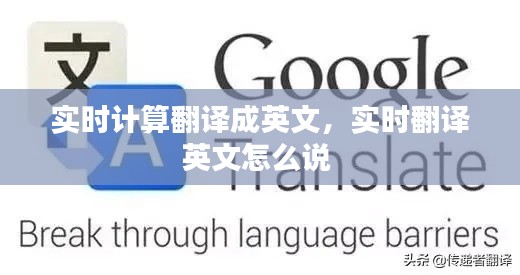Introduction to Real-Time Translation
In the age of globalization, communication across languages has become more crucial than ever. With the rapid advancement of technology, the concept of real-time translation has emerged as a game-changer in the field of language services. Real-time translation refers to the ability to translate spoken or written language instantly, allowing for seamless communication between individuals who speak different languages. This article delves into the world of real-time translation, exploring its significance, challenges, and future prospects.
How Real-Time Translation Works
Real-time translation is made possible through a combination of sophisticated algorithms, artificial intelligence, and powerful computing systems. At its core, the process involves the following steps:
Input: The user provides the source language text or audio input.
Processing: Advanced algorithms analyze the input and identify the language and context.
Translation: The algorithms generate a translation in the target language, taking into account grammar, syntax, and cultural nuances.
Output: The translated text or audio is delivered to the user in real-time.
Modern real-time translation systems can handle a wide range of languages and dialects, making them highly versatile tools for global communication.
Applications of Real-Time Translation
Real-time translation has found applications in various fields, including:
International Business: Real-time translation facilitates negotiations, meetings, and collaborations between businesses operating in different countries.
Healthcare: Medical professionals can use real-time translation to communicate with patients who speak different languages, ensuring better patient care and understanding.
Education: Language learning platforms and educational institutions can incorporate real-time translation to enhance the learning experience for multilingual students.
Travel and Tourism: Real-time translation apps help travelers navigate foreign countries and communicate with locals, making travel more accessible and enjoyable.
Public Service: Real-time translation can be used in government meetings, press conferences, and public forums to ensure inclusivity and accessibility for all participants.
These applications highlight the versatility and importance of real-time translation in our increasingly interconnected world.
Challenges and Limitations
While real-time translation has made significant strides, it still faces several challenges and limitations:
Language Complexity: Some languages are more complex than others, making accurate translation more challenging.
Cultural Nuances: Real-time translation systems may struggle to capture the subtleties and cultural nuances of certain languages, leading to potential misunderstandings.
Speech Recognition: Accurate speech recognition is crucial for real-time translation, and current systems may still face difficulties in understanding accents, dialects, and informal language.
Latency: Although real-time translation aims to provide immediate results, there can still be delays in processing and delivering the translation.
Addressing these challenges requires continuous research and development in the field of artificial intelligence and computational linguistics.
The Future of Real-Time Translation
The future of real-time translation looks promising, with several developments on the horizon:
Improved Accuracy: As AI algorithms become more advanced, the accuracy of real-time translation is expected to improve, reducing the potential for errors and misunderstandings.
Enhanced User Experience: New technologies, such as augmented reality (AR) and virtual reality (VR), may integrate real-time translation into immersive experiences, making communication even more seamless.
Broader Language Support: With the increasing demand for multilingual communication, real-time translation systems are likely to expand their language support, catering to a wider range of users.
Accessibility: Efforts to make real-time translation more accessible to individuals with disabilities, such as those who are deaf or hard of hearing, are ongoing, ensuring inclusivity in communication.
As technology continues to evolve, real-time translation is poised to become an indispensable tool for global communication, breaking down language barriers and fostering a more connected world.
Conclusion
Real-time translation has revolutionized the way we communicate across languages. With its vast applications and continuous advancements, it is clear that real-time translation will play a crucial role in shaping the future of
转载请注明来自互诺实验设备(衡水)有限公司,本文标题:《实时计算翻译成英文,实时翻译英文怎么说 》












 冀ICP备2024085275号-1
冀ICP备2024085275号-1